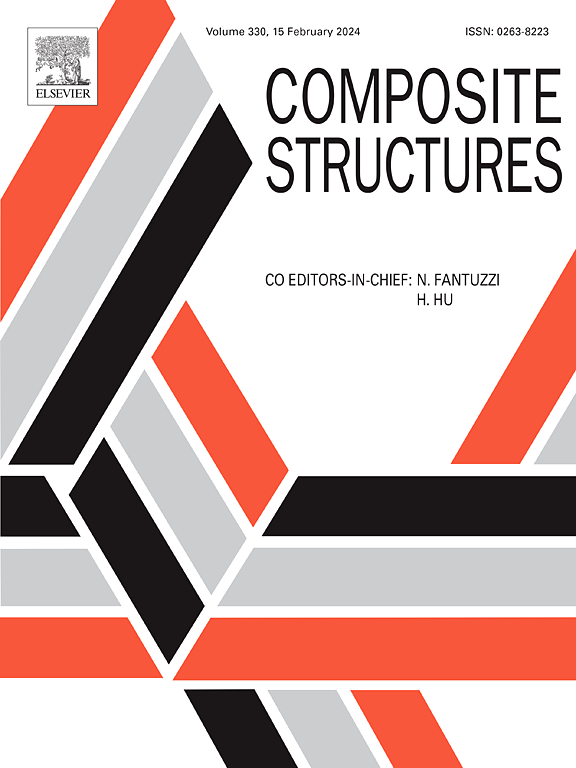Multiscale analysis of elastic properties of 3D-printed carbon fiber-reinforced nylon-based composites: Numerical approach
IF 6.3
2区 材料科学
Q1 MATERIALS SCIENCE, COMPOSITES
引用次数: 0
Abstract
This paper reports the investigation of the elastic properties of 3D-printed carbon fiber-reinforced nylon-based composites (CFRNCs) using experiments and multi-scale numerical modeling. Short-cut carbon fiber-reinforced nylon-based composites (sCFRNCs) and continuous carbon fiber-reinforced nylon-based composites (cCFRNCs) laminates were printed, and a comprehensive set of experimental data for their elastic properties was obtained. Some data were used to calibrate the material parameters of the printed filaments, and the rest were employed to assess the predictive capability of the multi-scale numerical model at determining the elastic parameters of macroscale 3D-printed laminates. Also, the elastic parameters of microscale printed filaments and mesoscale unidirectional laminas were determined. Unlike conventional models, this model considered the structural characteristics of the 3D-printed laminates, where each layer of the laminates was divided into a wall zone, edge zone, and unidirectional laminate zone at the macroscale. The results showed that the reinforcement in both the carbon fiber (CF) filaments and Onyx filaments was T300 CF monofilaments, while the matrix was different types of nylon materials. The predicted tensile modulus of CF filaments closely matched the experimental values reported in the literature, with an error of −0.95 %. Similarly, the predicted elastic properties of 3D-printed laminates agreed well with the experimental results, while the multi-scale model performed better for the 0° cCFRNCs laminates than the multi-directional cCFRNCs laminates. For the 0° laminates, the absolute error was less than 5.5 %, but for the multi-directional laminates, the absolute error was less than 9 %, with a few exceptions. In addition, a linear relationship was found between the tensile modulus and the mesoscale fiber volume fraction in 0° laminates, similar to the rule of mixtures (ROM) model. The results revealed that the ROM model served as a simplified model to replace the multi-scale numerical model for 0° cCFRNCs laminates when the influence of the edge zone was appropriately considered. An attempt was also made to employ a coordinate transformation (CT) method to simplify the multi-scale numerical model for off-axis multi-directional laminates. The results indicated that this method was ineffective when the edge zone was not considered.
3d打印碳纤维增强尼龙基复合材料弹性性能的多尺度分析:数值方法
采用实验和多尺度数值模拟的方法研究了3d打印碳纤维增强尼龙基复合材料(CFRNCs)的弹性性能。打印了短段碳纤维增强尼龙基复合材料(sCFRNCs)和连续碳纤维增强尼龙基复合材料(cCFRNCs)层合板,并获得了一套完整的弹性性能实验数据。部分数据用于标定打印细丝的材料参数,其余数据用于评估多尺度数值模型在确定大尺度3d打印层压板弹性参数方面的预测能力。测定了微尺度印刷细丝和中尺度单向板的弹性参数。与传统模型不同,该模型考虑了3d打印层压板的结构特征,其中每层层压板在宏观尺度上分为壁区、边缘区和单向层压板区。结果表明:碳纤维长丝和缟玛瑙长丝的增强材料均为T300 CF单丝,基体为不同类型的尼龙材料;预测的CF纤维拉伸模量与文献报道的实验值非常吻合,误差为- 0.95%。同样,3d打印层压板的弹性性能预测与实验结果吻合较好,而多尺度模型对0°ccfrnc层压板的性能优于多向ccfrnc层压板。对于0°层压板,绝对误差小于5.5%,但对于多向层压板,绝对误差小于9%,但有少数例外。此外,在0°层压板中,拉伸模量与中尺度纤维体积分数之间存在线性关系,类似于混合规则(ROM)模型。结果表明,在适当考虑边缘区影响的情况下,ROM模型可以作为0°ccfrnc层合板的简化模型来代替多尺度数值模型。并尝试采用坐标变换(CT)方法对离轴多向层合板的多尺度数值模型进行简化。结果表明,当不考虑边缘区域时,该方法是无效的。
本文章由计算机程序翻译,如有差异,请以英文原文为准。
求助全文
约1分钟内获得全文
求助全文
来源期刊

Composite Structures
工程技术-材料科学:复合
CiteScore
12.00
自引率
12.70%
发文量
1246
审稿时长
78 days
期刊介绍:
The past few decades have seen outstanding advances in the use of composite materials in structural applications. There can be little doubt that, within engineering circles, composites have revolutionised traditional design concepts and made possible an unparalleled range of new and exciting possibilities as viable materials for construction. Composite Structures, an International Journal, disseminates knowledge between users, manufacturers, designers and researchers involved in structures or structural components manufactured using composite materials.
The journal publishes papers which contribute to knowledge in the use of composite materials in engineering structures. Papers deal with design, research and development studies, experimental investigations, theoretical analysis and fabrication techniques relevant to the application of composites in load-bearing components for assemblies, ranging from individual components such as plates and shells to complete composite structures.
 求助内容:
求助内容: 应助结果提醒方式:
应助结果提醒方式:


